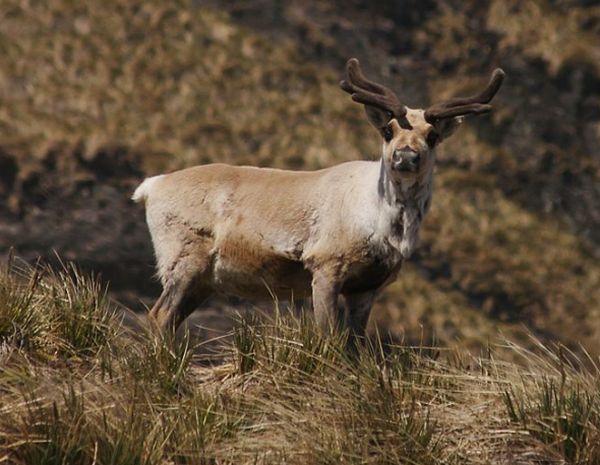
It seems like reindeers have a visionary capacity more pronounced than humans because they can not only see visible light, but ultraviolet (UV) light also. This discovery was recently made by researchers from the University College, London. Lead researcher Professor Glen Jeffery believes that it is this ability to see in ultraviolet light enables the animal to survive in the cold arctic conditions.
In humans, exposure to UV light may result in temporary but very painful condition called ‘snow blindness’. Most other mammals too have eyes that do not register UV light and therefore cannot see in such conditions. But reindeers, according to the research team, can easily see in UV light and make sense of the images to find food or to save themselves from predators. The sun’s rays emit light through a wide spectrum and humans can see only specific wavelength of light. In reindeers though, the researchers found that their vision allows them to see even at wavelengths down to around 350 – 320nm near to the UV end.
This is an extremely beneficial adaptation in the arctic region where the sun barely rises and the limited amount of sunlight that does reach the ground is mostly scattered UV ray or blue light. Also due to the presence of snow almost 90 percent of the UV light is reflected. This unique survival adaptation in reindeer allows them to locate food, take shelter, protect themselves from predators and also avoid territorial conflicts. The scientists have been able to discover the ability of reindeers to see in ultraviolet light, more research is still needed to know how their eyes are not harmed by this light. If the discovery can be made, it can definitely help in developing new ways to treat or prevent the damage UV light causes to human eyes.
The Reindeer:
Reindeers (Rangifer tarandus) are a kind of deer that inhabit the arctic and subarctic tundra regions. They are also known as caribou in North America. There are a number of subspecies of the animal though some of these subspecies have already become extinct.
The male reindeers are generally larger than females weighing 90-210 kg and 180-214 cm tall. Female usually have an average height of 162-205 cm and weigh 79-120 kg. The main distinguishing feature of these animals is the antlers seen in both males and females although the latter have smaller antlers than the former. There are also a few subspecies where females do not have any antlers.
There was once a time when reindeers were found in far South Nevada, Tennessee and Spain but now wild reindeer have disappeared from many locations. Norway, Canada, Siberia, Alaska, Finland and Greenland are presently some places where these wild animals can still be seen.
Interesting characteristics:
- The unique eyesight allows reindeer to see predators like wolves and also find scarce winter food.
- The fur color of the animals varies with season and subspecies. Northern population usually has a lighter fur color than the southern ones.
- The antlers of older males usually fall off in December and for younger males in early spring time. In females the antlers fall off in summer. These antlers are grouped into smaller lower ones and larger upper ones.
- The nose of the animals too are adapted to bear extreme cold. There are nasal turbinate bones that increase the surface area inside the nose of the animals. Therefore when cold air is breathed in, it first gets a little warmer using the animal’s body heat. In the same way when air is breathed out, water is condensed before exhalation. This helps in moistening the dry incoming air.
- The hooves adapt according to the season. In the wet and soft tundra of summers, the foot pads are sponge-like to allow extra traction and in the icy cold winters, the pads shrink with the hooves protruding out and allowing the animal better grip on the icy floor.
- Like cows, reindeer have a four chambered stomach. Their favorite winter food is lichens also known as reindeer moss but they also eat leaves of willows, birches etc.
- Mating takes place from late September to early November. Males usually lock their antlers to fight and win over as many females possible for mating ranging from 15 to 20. During this time males lose a lot of body fat and eat very less.
- North American Caribous are known to migrate 5000 km annually covering 1,000,000 km.
- Reindeer can swim very well because of their thick coat. It allows air to get trapped inside and provide the buoyancy required to float.
- Nomadic tribes living in Arctic areas like the Lapps have domesticated these animals for ages. They are an important source of butter, meat, cheese, clothing, and also for transportation. The antlers and bones come in handy to make tools and utensils. The sinews found in the legs are used to make thread.
- Excessive hunting and habitat destruction are leading to decrease in their number.



